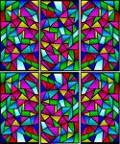
 |
 |
 |
 |
Stained Glass Reviews
Stained Glass Lead Came Technique
Stained Glass Lead Came Technique
The lead came method of stained glass construction gives an appearance of like lines and an antique look. The lead channel is wrapped around the glass and then joined at the " seams " or joints by a bead of solder.
Lead came, used for joining pieces of stained glass, comes in one channel, called " U came, " or two channel, " H came, " strips about six feet long. " U " lead strips are used to frame the outside edges of stained glass, especially on small suncatchers or ornaments with only two or three glass pieces. In larger stained glass projects, the " H " lead strips are used to join two pieces of glass together, placed inside the grooves.
Stretching the lead strips before fitting it around the stained glass makes the lead more rigid and stronger. Some lead is pre - outstretched, but might have acquired some kinks or bends in packaging, so you may want to stretch it a little to get the kinks out. Do not over - stretch as it will narrow the grooves in the channel, making it too narrow to fit around the stained glass. Lead that is stretched too much will break.
The lead is soft enough that after fitting it on the stained glass and making hard that you have good connections, you can easily cut it with lead nippers, a lead knife or even scissors. Be careful to make sure the joints you have cut butt so that it will be strong throughout the stained glass piece. Filling gaps between the joints takes a lot of solder and makes the joints look sloppy and unprofessional.
Your stained glass work will be laid on a pine board, beginning at two strips of wood nailed at right angles to each other. These wood strips will fulfill as a brace for your project. Your alternating pieces of lead and stained glass will be temporarily held in place by horseshoe nails as you persevere across your stained glass motif.
Each piece of stained glass and the lead strip around it has to fit within the pattern lines before you move on to the next piece. If one piece is too large and crosses over the pattern line, then every unsimilar piece will be off and your entire stained glass piece will be off.
Before you begin soldering the lead joints on your stained glass project, you should exposure on some fracas pieces of lead first. Lead melts so you want to check your soldering iron's temperature on the lead scraps first. If it is too hot, a rheostat can lower the temperature enough to prevent unwanted melting of the lead. A 40 watt soldering iron is smoking enough.
Before you solder the lead joints, prepare the metal with flux, then move your soldering iron tip swiftly over the lead, creating a pool of the 60 / 40 solder. The pool of lead should smoothly fall over the seams and lie flat. It is not necessary to raise a big barbecue of solder at the joints.
Solder all joints on both sides of your stained glass panel. Clean the flux away with warm, soapy water. Reinforce the stained glass panel by forcing a glazing compound or multifaceted into the lead channels. Clean away all excess putty with whiting or sawdust, and then a soft textile.
Another method of joining stained glass, created by Louis C. Tiffany, is the copper foil method of stained glass diagram. The glass crafter can choose which method he / she prefers based on each individual stained glass project. Both methods of stained glass construction generally work equally well.
 |
 |
 |
How Much Will A Custom Stained Glass Window Cost
A Brief History Of Stained Glass
Stained Glass Artisan, Louis C. Tiffany
Stained Glass Copper Foil Technique
Stained Glass Projects For Children
How To Repair Your Stained Glass Window
Stained Glass Windows A Light Unto The Soul
Accountancy
Acupuncture
Adoption
Affiliate Marketing
Alternative Energy
Alzheimers
American History
Anger Management
Aquarium
ATV
Autograph Collecting
Bachelorette Parties
Bargain Hunting
Bathroom Accessories
Beauty
Belgian Chocolate
Bipolar
Black History
Blog Marketing
Bodybuilding Supplements
Body Detox
Body Jewelry
Building Self Esteem
Business
Career Hunting
Caring For The Elderly
Choosing The Right
Golf Clubs
Christmas Shopping
More Stained Glass Reviews
Designing Your Own Stained Glass
... Either way, your first few projects will probably be made either from a pre - made kit or with a pattern from a book or printed from a website. You may soon decide that you are like mad to create your own stained glass design and hump it to life. Although the idea may seem daunting at first, you will ...
Enhance The Beauty Of Your Garden With Stained Glass Art
... flowerbed, tree, birdbath, backyard pond, sundial or herb garden. If you aren't familiar at scoring, breaking and grinding stained glass, just break random scraps of stained glass and arrange them in a design, or in no inbred design, in your concrete form. You can buy easy - to - make stepping stone kits ...
How Much Will A Custom Stained Glass Window Cost
... rondels added to the design, these will upsurge the price of your custom stained glass window. Some gems are more expensive than others, and these add to the intricacy of the work to be done. Distinctive considerations in the overall cost of your stained glass window are installation and how it will be ...
Stained Glass Artisan, Louis C. Tiffany
... glassmaking, he came up with his beautiful " drapery " stained glass which he used to represent the folds and ripples in the robes and gowns of figures in his stained glass windows. Tiffany's first constitution stained glass window was built in 1878 using opalescent glass from the Heidt glasshouse. He ...

|
| Copyright © 2006-2012 Internet Marketing Tools, All Rights Reserved |